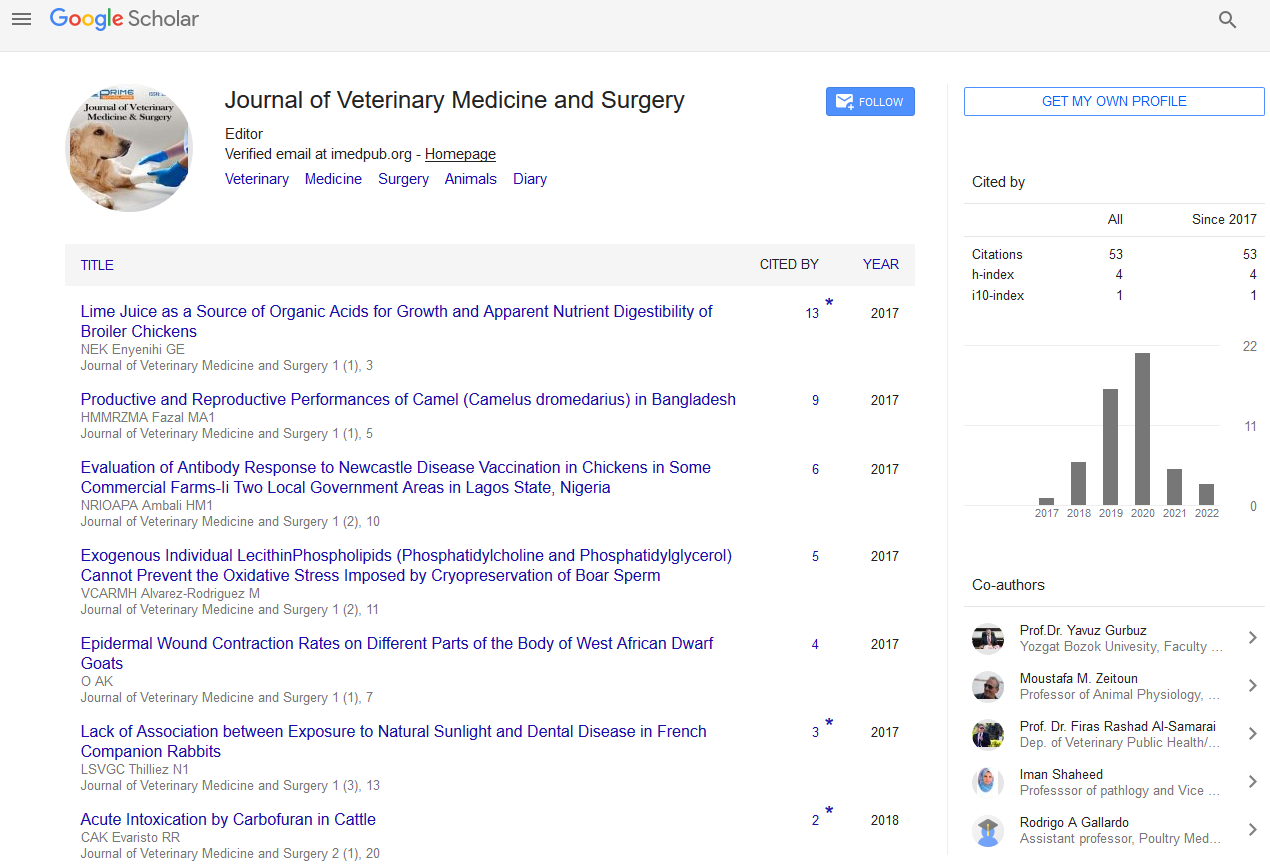Short Communication - (2024) Volume 8, Issue 4
An Introduction to Veterinary Medicine: Healing and Caring for Animals
Hana Yuki*
Department of Veterinary Sciences, Nihon University, Japan
*Correspondence:
Hana Yuki,
Department of Veterinary Sciences, Nihon University,
Japan,
Email:
Received: 02-Dec-2024, Manuscript No. IPJVMS-24-21920;
Editor assigned: 04-Dec-2024, Pre QC No. IPJVMS-24-21920(PQ);
Reviewed: 18-Dec-2024, QC No. IPJVMS-24-21920;
Revised: 23-Dec-2024, Manuscript No. IPJVMS-24-21920(R);
Published:
30-Dec-2024, DOI: 10.36648/2574-2868.8.4.31
Introduction
Veterinary medicine is a branch of medical science that focuses
on the diagnosis, treatment, and prevention of diseases
and injuries in animals. While most people are familiar with
veterinary care for household pets like dogs and cats, the field
encompasses a broad range of species, from livestock and
wildlife to exotic animals. Veterinary medicine plays a critical
role in safeguarding both animal health and public health,
as it is often linked to zoonotic diseases-those that can be
transmitted from animals to humans.
Description
Veterinarians are highly trained professionals who provide
medical care for animals. Their responsibilities include
diagnosing and treating illnesses, performing surgeries,
prescribing medications, and providing preventive care, such
as vaccinations and health screenings. Veterinarians also
play a key role in controlling animal populations, particularly
in managing herd health for livestock, controlling disease
outbreaks, and ensuring food safety. Specializations within
veterinary medicine are numerous, reflecting the diversity of
animal species and health issues. Some veterinarians focus on
small animals (pets like dogs, cats, and rabbits), while others
specialize in large animals (livestock such as cows, pigs, and
horses) or exotic animals (including reptiles, birds, and marine
mammals). Some vets even work in fields like veterinary
pathology, surgery, internal medicine, and emergency and
critical care. One of the primary goals of veterinary medicine is
to keep animals healthy and prevent disease before it occurs.
This includes routine check-ups, vaccinations, parasite control,
and dental care. Preventive care is crucial not only for the
well-being of individual animals but also for public health.
For example, vaccines for diseases like rabies or distemper
help prevent outbreaks that could affect both animals and
humans. Becoming a veterinarian requires extensive education
and training. In most countries, prospective veterinarians
must complete a veterinary school program after obtaining
an undergraduate degree, which typically takes about 8-10
years in total. Veterinary students undergo rigorous academic
coursework in subjects such as anatomy, pharmacology,
microbiology, pathology, and surgery. In addition, they gain
hands-on experience in veterinary clinics or hospitals through
internships and clinical rotations.
Some veterinarians choose to pursue further specialization by
completing residency programs or earning board certifications
in areas like surgery, dermatology, cardiology, or oncology.
Specialization typically requires additional years of training
beyond veterinary school. The field of veterinary medicine
continues to evolve as new technologies and treatments
become available. Advances in genetic research, telemedicine,
and veterinary robotics are shaping the future of animal care.
For example, telemedicine allows veterinarians to remotely
diagnose and treat certain conditions, making care more
accessible for pet owners in rural or underserved areas.
Similarly, the use of Artificial Intelligence (AI) and machine
learning is improving diagnostic accuracy and treatment
planning. Veterinarians are also playing a larger role in
conservation efforts, working with endangered species and
supporting sustainable practices in wildlife management and
biodiversity preservation. As concerns over climate change,
habitat destruction, and species extinction grow, the role of
veterinarians in protecting animal populations is becoming
increasingly critical [1-4].
Conclusion
Veterinary medicine is a vital and diverse field that contributes
to the health and well-being of animals and humans alike.
By providing comprehensive care, ensuring food safety,
controlling disease outbreaks, and promoting animal welfare,
veterinarians make essential contributions to society. As
science and technology advance, the field of veterinary
medicine will continue to evolve, offering new opportunities
to improve animal health and strengthen the human-animal
bond. Whether treating a pet dog, working with livestock on
a farm, or protecting wildlife in a natural reserve, veterinary professionals play a crucial role in preserving the health of the
world’s animals and maintaining the delicate balance between
humans, animals, and the environment.
Acknowledgement
None.
Conflict Of Interest
None.
References
- Urfer SR, Kaeberlein M (2019) Desexing dogs: A review of the current literature. Animals (Basel) 9(12):1086.
[Crossref] [Google Scholar]
- Howe LM (2015) Current perspectives on the optimal age to spay/castrate dogs and cats. Vet Med (Auckl) 6:171-180.
[Crossref] [Google Scholar]
- Vendramini THA, Amaral AR, Pedrinelli V, Zafalon RVA, Rodrigues RBA, et al. (2020) Neutering in dogs and cats: Current scientific evidence and importance of adequate nutritional management. Nutr Res Rev 33(1):134-144.
[Crossref] [Google Scholar]
- Valtolina C, Vaandrager AB, Favier RP, Tuohetahuntila M, Kummeling A, et al. (2017) Sex specific differences in hepatic and plasma lipid profiles in healthy cats pre and post spaying and neutering: Relationship with feline hepatic lipidosis. BMC Vet Res 13(1):231.
[Crossref] [Google Scholar]
Citation: Yuki H (2024) An Introduction to Veterinary Medicine: Healing and Caring for Animals. J Veterinary Med. 8:31
Copyright: © 2024 Yuki H. This is an open-access article distributed under the terms of the Creative Commons Attribution Li-
cense, which permits unrestricted use, distribution and reproduction in any medium, provided the original author and source
are credited.

